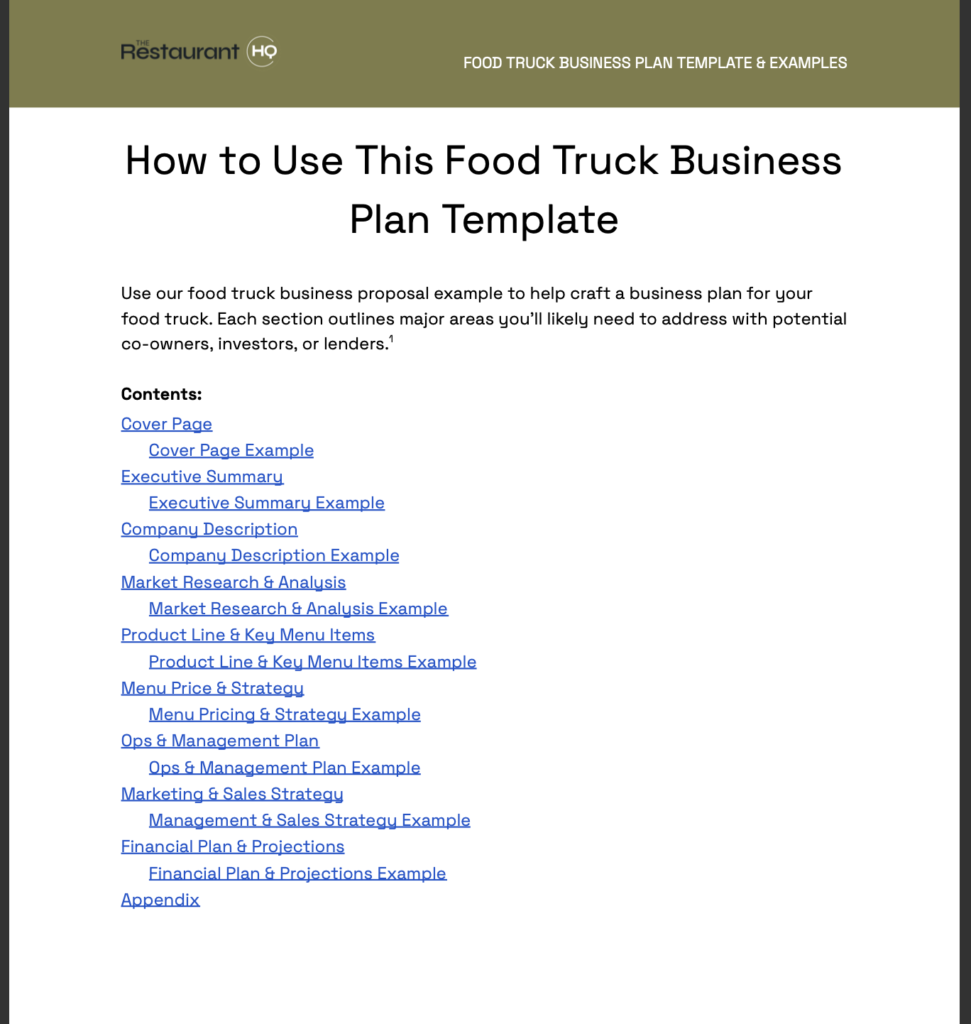Food trucks are some of the most accessible food businesses one can launch in 2025. The ability to test out food concepts, sell products with low overhead costs, and go where customers are located makes it one of the most appealing food business models for food entrepreneurs.
Food trucks are very easy to set up and can be duplicated efficiently. For optimal success in food truck ownership, you’ll need a food truck business plan. Your plan is a document that includes an executive summary and a company description, as well as outlines your market research and analysis, product line and key menu items, pricing and marketing strategies, operations plan, and financial projections.
Review how to build out a food truck business plan (or download our food truck business plan template) and ensure your food truck is set up for success.
Download a free food truck business proposal template
We know writing a food truck business plan can be daunting. Download our free food truck business proposal template to reel in potential investors, entice a business partner, or secure a bank loan.

9 steps for an effective food truck business plan
Starting a food truck and starting a restaurant aren’t the same thing. If you are looking to write a food truck business plan, then understanding the many different steps in creating it successfully is very important. The steps to writing a business plan flow from the overall summary of your business to operations and product offerings and, finally, into expected profitability and scalability. Below are the steps you should follow when considering writing a food truck business plan.
1. Write an executive summary
The executive summary of your business plan offers a brief but important overview of the food truck business you are trying to build. It should include your mission statement, what makes your product offering unique, and the overall branding of your food truck. The executive summary should also be a succinct introduction to potential investors, detailing the gap you have found in your proposed customer base and why your business will fill this gap and be successful.
We suggest writing this part last, even though it is the first part of your business plan because it summarizes the entire plan. By writing it last, you can distill down key information that will be important when trying to persuade investors to support your business.
2. Draft a compelling company description
The company description section includes your brand name, logo, and other brand identifiers. It will also further identify your proposed operating locations and explain why you chose them. The company description will also detail the target market and related demographics.
Finally, you should disclose the legal structure of your business in this section. Investors need to know how your business is legally structured, whether an LLC or a partnership. The company description details your brand, the customers you aim to serve, and how you’ll structure your food truck business.
This section should also focus on what kind of truck you will be using and why your food truck is better as a truck compared to a standard brick-and-mortar restaurant location. Consider including a general overview of whether your product will be prepared in the truck or at another site, why your product offering is unique to your target market, and how you plan on scaling your business.
3. Conduct market research and analysis
Your market research should compile key information on the food truck industry in your region and demonstrate why your truck will stand a chance of success in it. I highly recommend analyzing other food trucks and brick-and-mortar restaurants competing with your business that serve similar products. This section of the business plan focuses on your target demographic and the competitive businesses that also focus on it.
Your market research might include:
- Current trends, your target consumer group, and overall themes affecting the food truck industry in your region.
- The size and growth potential of your customer base.
- Your pricing structure and why it’s competitive against other businesses.
- Your main competitors and market forces that could challenge business performance.
- A high-level plan on how you’ll capture a majority of your market.
Some of the best market research is in-person and on foot in your prospective selling region, according to Reddit users: “Also, check with some local restaurants and other businesses in the area you are looking to set up. That will give you an idea of foot traffic that may come thru.”
4. Product line and key menu items
When it comes to running a food truck vs a restaurant, the dishes you prepare — and how you present them — couldn’t be more different. Your food truck business plan showcases your key menu items to potential investors in an exciting and easy-to-navigate way.
For example, if you want to run a taco truck, breaking down your different taco options, sides, drinks, and other menu items is key, given that they account for 25% of the market, according to food truck industry statistics.
You want to show that your menu is well thought out, each item unique, and products offer value to your bottom line and customer base. This section should explain the cuisine type, the dishes served, and why customers will choose your food truck over others
One piece of information that some miss in the food truck space is menu evolution. I recommend sharing your process for updating your menu or what it will look like to add new items. While it may seem small, conveying flexibility in your product offerings will be useful if certain items don’t meet your financial expectations. You can also share how your menu leads to the growth of your business, which investors look for in business types such as food trucks.
5. Menu pricing and strategy
While the section above will break down your pricing goals and strategy, this section will take a deep dive into the core menu offerings your truck delivers and the pricing strategy you’ll implement to make a profit. This section needs to provide a clear overview of your food cost for each menu item and how you plan to manage it.
The strategy involved with this can include your operational systems for taking inventory, ordering product pars efficiently, and managing local vendor relationships. Your vendors and how you source ingredients will fit into food costs, so naturally, this information will be included in this section.
Once costs are established, share your profit margins and how each dish adds to the overall core of the business. Explaining to investors why the build-out of your menu will lead to a profitable outcome is key to ensuring that they feel confident in your business model and proposed execution. Finally, comparing your food cost, pricing, and other key information against local market averages and rates is vital to conveying that your menu pricing is reasonable for customers in your market.
6. Ops and management plan
This section will first review your food truck and all the equipment you need to operate when serving customers. Your legal structure, co-owners, how the company is split up, and any other relevant ownership information will be assessed in this part of your food truck business plan.
Additionally, include your managerial team, how your staff is organized, and how you plan on managing your employees. Managers or owners need to list relevant accomplishments to show the experience they bring to your business.
Consider a deep dive into your operational flow in this section. This includes workflow, employee responsibilities, managerial responsibilities, and station responsibilities. How you cook food, your process for taking orders, and how you serve your customers must also be detailed here.
The last important bit in this section is how your food truck will adhere to and comply with local food laws. You should have an SOP or checklist on how you will handle health inspector visits and other regulatory requirements. This section must also include labor cost projections and the overall staffing requirements during operating hours.
7. Marketing and sales strategy
Having a good food truck concept or menu idea is great, but if nobody knows your business exists, then you will fail. Food truck marketing is aggressive and diverse and has to appeal to a wide range of people in a smaller regional footprint. Sharing how you plan to advertise your food truck business is very important. I recommend having strategies for each social media platform you’ll be on, as the content you will post on TikTok will vary against content on Facebook.
You can also market your food truck through loyalty programs, discounts, or special occasion pricing. The flexibility of the food truck also requires you to share why your food truck locations are key to marketing to prospective customers. Finally, I suggest implementing plans for corporate catering, serving events such as weddings, and large crowd gatherings such as concerts or festivals.
8. Financial plan and projections
The last major part of your food truck business plan must be your financial plan and projected financial activity. This section should list your starting cost estimate with a complete cost breakdown. This will give transparency to investors and show them where their money is being put to work.
Additionally, your revenue projections can span both daily and monthly sales, with key insights on how you can improve these projections over time if needed. This section also needs a thorough breakdown of food, labor, fuel, and marketing expenses.
One of the more pressing questions investors will have is when you expect your business to break even. The break-even analysis details exactly when your business goes from being in debt to being profitable. It’s super informative when investors decide whether or not your food truck is the right fit. The last bit of information to share is any future funding you may require and your plan to pay back loans or investments from potential investors.
Even users on popular food truck Reddit threads suggest completing this section last: “Now, to be able to complete the financial planning, you will need to have a pretty good understanding of your product, market, competitors, and business/revenue model. Those are also your key chapters in the business plan.”
9. Appendix (optional)
The appendix is a useful place to fit in relevant bits of information that do not cleanly fit into any of the sections above. This can include items such as building permits, ServSafe certifications, quotes for food truck insurance, letters of reference, or sample menus. Furthermore, the appendix can include the owners’ resumes, any licenses needed for the business, and additional market research you and your team may have conducted for the business.

Why you need a food truck business plan
Creating a business plan for any food business is integral to properly launching your brand. While food trucks are simpler to open than restaurants, they require quite a bit of planning, oversight, and consistent execution to be successful. Here are my top reasons you should consider a business plan for a food truck:
- It defines your brand vision.
- It can help secure funding.
- It can help identify challenges and setbacks.
- It ensures compliance with health and safety regulations.
- It provides a clear roadmap.
It defines your brand vision
Defining the goal for your food truck is a key reason you should consider a business plan. This planning process will help determine the type of food your truck will sell, how you will offer this product to customers, and where your food truck will do business. The food truck business plan defines the goal of your brand and what type of menu you will offer.
It can help secure funding
A business proposal for a food truck will often require a business plan, which is a key tool in securing funding. Prospective investors will want to know your business, what products you’ll sell, and how you plan on making a profit. A business plan clearly articulates to investors what they are investing in and how they will gain from the investment in your food truck.
It can help you identify challenges and setbacks
Another key aspect of a food truck business plan is identifying challenges your food truck may face. If you can identify the challenges that could affect your food truck, you can better plan and execute in preparation for said challenges. Furthermore, identifying challenges in your business plan can help shape your business to be more resilient to the industry’s hurdles.
It ensures compliance with health and safety regulations
A food truck business plan will include key compliance initiatives you need to take to be in good standing as a food business. The business plan details any permits, inspections, or regulatory actions required to ensure your business operates safely and legally.
Reddit users agree compliance is key to starting out: “I would say getting a business plan together and figuring out your financing is going to come before purchasing equipment. That’s going to tell you how much you can afford to spend, which will inform your decisions about where to purchase the equipment needed.
After that, I would consult with the health department in your jurisdiction to find out what rules and regulations apply to your business (again.. probably difficult if you have no frame of reference.)”
It provides a clear roadmap
Finally, a business plan defines your roadmap to ensure your food truck succeeds. This roadmap details key points in your business journey and ensures your business is ready to capitalize on success once these milestones are met. The ability to map out your business allows you to plan for your food truck’s growth, expansion, and long-term success in a super valuable way before launching the brand.
How to present a food truck business plan
Presenting your business plan to potential food truck investors is as important as the plan itself. Your presentation needs to instill confidence in investors that the food truck business you are seeking investment for is well planned out. Your presentation should highlight your business model, your truck’s unique product offering, and other relevant information. Below are the steps you should consider when presenting your food truck business plan.
1. Executive summary presentation
When presenting your business plan, it is key to provide a high-level overview of your food truck concept. This section should detail the truck’s origin story or inspiration, its name, and the general concept. You should also include your target customer, unique menu items or products, supplies, and the branding you aim to use to market your menu. Finally, you should present your business’s vision, broad financial targets, and relevant startup financial information.
2. Food truck breakdown
Your next objective should be to explain in depth the concept of your food truck and why you believe it will be successful in this business model. This section should highlight your core product offerings and why they are unique and marketable to the customers you aim to serve. Furthermore, you should share why this menu is the one you chose. This is the time to share your passion for your product and the personal decisions behind your desire to start a food truck.
3. Menu details
Where the step above highlights your core products, this step in the presentation will highlight your menu items with mock pricing. You can also share what dishes will rotate in and out due to seasonality or demand. It would be extra beneficial if you could provide live samples for this part of the presentation. For example, if you are a taco truck, sampling what you believe to be products that will sell the most is a great idea. I recommend this, as it creates a tangible product an investor can actually assess and react to.
4. Market analysis
After you break down your menu, share why you chose the items you did and how your target consumer base will receive this offering. Your market analysis should also cover industry trends in your region specifically, focusing on how food trucks perform or any gaps you can capitalize on in your regional market. Offering a competitive analysis is also important, as this shows your investors that you are prepared to be a competitive business.
5. Brand strategy
The conversation of competitive business analysis and your regional market should naturally flow into your brand strategy and how you will market to your customers. Your truck’s logo, colors, and design should be shared here, along with the reason behind your brand design. This will lead to how you plan on marketing your truck via social media, target ads, or location selection. Defining where your truck will serve food is a key part of this presentation and the overall marketing strategy of your food truck.
6. Finance and ops plan
Next, you should share your financial plan. This includes startup costs, revenue projections, your break-even target, and projected funding needed from investors. Your operations plan presentation should include how you will prepare your products, staffing level goals, and the essential equipment and inventory you need to run the truck properly.
7. Growth and expansion
Investors will be interested in how your brand plans to grow and expand. A good food investment is one in which the core business has the potential and ability to grow and scale. By sharing your growth plan, you can really sell why the investment is so positive, as more growth adds value to the investor over time.
Your presentation to investors succinctly and engagingly breaks down key parts of your food truck business plan. Following the structure above, you can walk through the core business, the why behind your business, and how you plan to execute its success. Your investors should leave the presentation with a crystal-clear understanding of your food truck business and an excitement to invest in it.
Frequently asked questions (FAQs) about food truck business plans
When it comes to writing a food truck business plan, you need to be aware of a variety of aspects. Below are some of the most frequently asked questions regarding food truck business plans.
Last bite
As you can see, writing a detailed food truck business plan has many benefits. With proper planning, insightful analysis, and a focused concept, your food truck business plan will be the document that ensures success. Use our food truck business plan example to ensure your business is set up for success and can be operated and scaled efficiently and profitably.
ALSO READ



